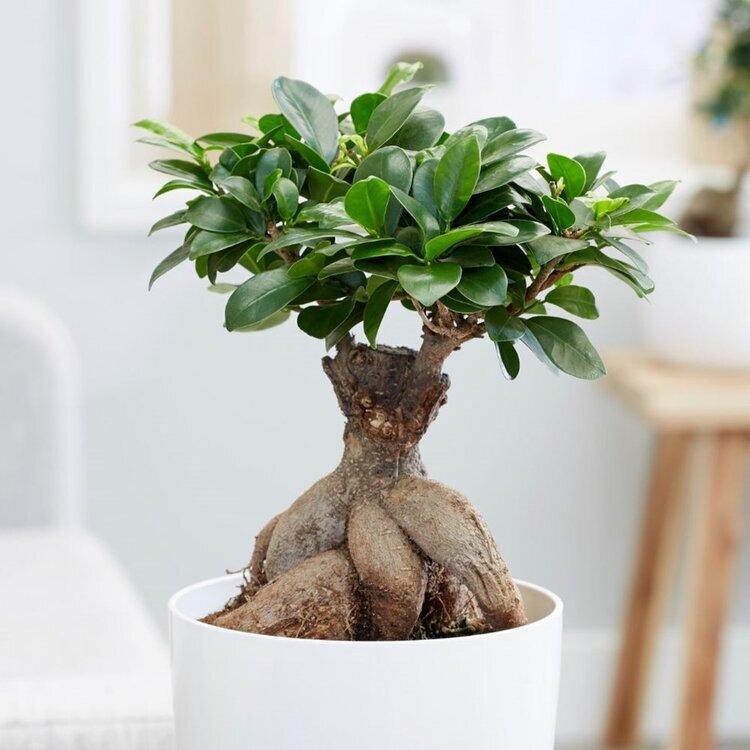
BONSAI
Bonsai is the Japanese tradition of keeping a tree small, while encouraging and cultivating its form as it matures. The word “bonsai” does not actually refer to a specific plant, but rather the specific process of tending to a tree or shrub as a bonsai. It can be thought of as more of a verb than a noun, as you “bonsai” a tree, a tree is not inherently a bonsai.
It is often thought that bonsai are dwarf varieties, but they are typically standard varieties that are kept small. This is largely why bonsai are kept in such small pots, as keeping the roots tight encourages the tree to remain small. Bonsai can be kept indoors or outdoors, depending on the species of plant and the zone you are growing them in. Some even move their bonsai seasonally, to give them optimal growing conditions in the warmer months, and over wintering them inside.
Tending and caring for a bonsai is often viewed as a meditative practice that offers a deepened connection to the natural world.
WATER
Water requirements of a bonsai vary depending on the type of plant and the container size. As bonsai typically live in shallow, broad pots, they often need water more frequently than the same plant would if it were grown in a standard deep nursery pot. Some plants can go fully dry, some surface dry, and others need to stay consistently moist. Due to this, it is important to know what type of plant you are growing, and always check the soil before watering.
When watering, you will want to water slowly and carefully over the soil surface to prevent any top soil, stones, or gravel from washing off or being displaced. You can also bottom water, which just means placing the pot into a bowl of water and allowing the soil to become saturated through the drainage holes. Whichever way you decide to water, make sure your plant is never left in standing water for prolonged periods of time.
SOIL
As with watering, the soil mix will depend on the variety of plant being kept as a bonsai. If the bonsai is a succulent plant, you can go ahead and use cactus or succulent mix. If it is a plant that prefers to be kept more moist, then you would want a soil mix that holds onto more moisture than a cactus mix would. A commonality of all bonsai is that they need good drainage, so make sure that whatever mix you use it can drain and dry out efficiently. Soil that never dries out can lead to root rot and other issues, even if watered carefully.
LIGHT
Bonsai are typically created using high light plants, as they are most often trees. Trees create canopies in nature, so it can be inferred that most have evolved to need high light due to this position. A Southern or Western exposure is preferred, as long as they are unobstructed.
Bonsai are not great plants for the deeper interior of spaces away from windows, without supplemental light provided by a grow light. A good rule is that the plant will want 6-8 hours of direct light every day.
FERTILIZER
When fertilizing a bonsai, take special care to use a mild dose of all purpose fertilizer. Exposed roots can be sensitive to highly concentrated doses of fertilizer. That said, because bonsai pots are shallow and typically have less potting medium, bonsai need to be fed gently throughout the growing season (spring, summer, fall), or whenever the plant is actively growing. To help protect sensitive or exposed roots, water your plant before applying a diluted liquid fertilizer.
Slow release fertilizer is also a great option to help prevent fertilizer burn.
SPECIAL NOTES & TRIMMING
Bonsai are typically trimmed to the liking of whoever is tending it. There are classic styles such as formal upright, cascade, semi-cascade, etc., which can be a good place to start when researching. Many of the foundational ideas behind bonsai trimming reflect that of larger trees in nature. For example, trees being grown in a semi-cascade style mimic trees that are growing over rock face or above streams, with a small section of the truck upright, then bending and stretching over the side of the container.
When trimming, you do not want to remove more than about ¼ to ⅓ of the foliage at a time, because removing too much at once can send the plant into shock. Cut limbs that are growing in conflict with one another, and remove any dead wood. To encourage the plant to become more bushy, the growth tips of branches can be pinched. Always use a sharp, sanitized pair of scissors or pruners.
Every 1 to 3 years, bonsai will need to be repotted–even if that is just back in the same pot with fresh potting medium. At this time the roots should be trimmed, removing matted or dead roots. Trimming the root system helps keep the plant small, and removing dead roots helps prevent rot and/or disease. The frequency of repotting will depend on the type of plant. Plants like Jade (a type of succulent that has a tree-like growth habit) tend to have more shallow and fine root systems, while plants like Ficus will grow roots abundantly.
Looking for more? Check out the blog over at the National Bonsai foundation



